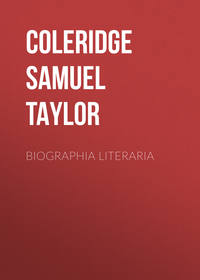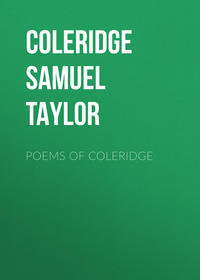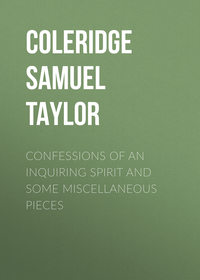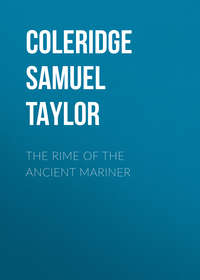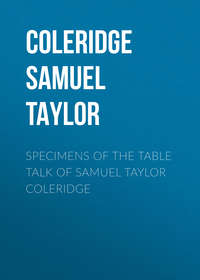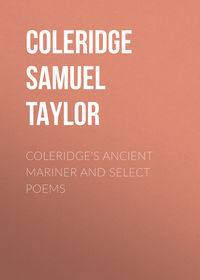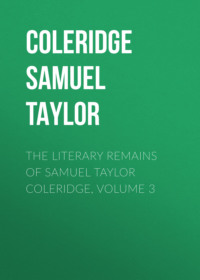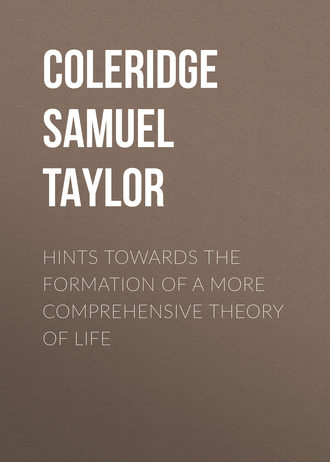 полная версия
полная версияHints towards the formation of a more comprehensive theory of life
In all cases that which, abstractly taken, is the definition of the kind, will, when applied absolutely, or in its fullest sense, be the definition of the highest degree of that kind. If life, in general, be defined vis ab intra, cujus proprium est coadunare plura in rem unicam, quantùm est res unica; the unity will be more intense in proportion as it constitutes each particular thing a whole of itself; and yet more, again, in proportion to the number and interdependence of the parts, which it unites as a whole. But a whole composed, ab intra, of different parts, so far interdependent that each is reciprocally means and end, is an individual, and the individuality is most intense where the greatest dependence of the parts on the whole is combined with the greatest dependence of the whole on its parts; the first (namely, the dependence of the parts on the whole) being absolute; the second (namely, the dependence of the whole on its parts) being proportional to the importance of the relation which the parts have to the whole, that is, as their action extends more or less beyond themselves. For this spirit of the whole is most expressed in that part which derives its importance as an End from its importance as a Mean, relatively to all the parts under the same copula.
Finally, of individuals, the living power will be most intense in that individual which, as a whole, has the greatest number of integral parts presupposed in it; when, moreover, these integral parts, together with a proportional increase of their interdependence, as parts, have themselves most the character of wholes in the sphere occupied by them. A mathematical point, line, or surface, is an ens rationis, for it expresses an intellectual act; but a physical atom is ens fictitium, which may be made subservient, as ciphers are in arithmetic, to the purposes of hypothetical construction, per regulam falsi; but transferred to Nature, it is in the strictest sense an absurd quantity; for extension, and consequently divisibility, or multeity,11 (for space cannot be divided,) is the indispensable condition, under which alone anything can appear to us, or even be thought of, as a thing. But if it should be replied, that the elementary particles are atoms not positively, but by such a hardness communicated to them as is relatively invincible, I should remind the assertor that temeraria citatio supernaturalium est pulvinar intellectús pigri, and that he who requires me to believe a miracle of his own dreaming, must first work a miracle to convince me that he had dreamt by inspiration. Add, too, the gross inconsistency of resorting to an immaterial influence in order to complete a system of materialism, by the exclusion of all modes of existence which the theorist cannot in imagination, at least, finger and peep at! Each of the preceding gradations, as above defined, might be represented as they exist, and are realised in Nature. But each would require a work for itself, co-extensive with the science of metals, and that of fossils (both as geologically applied); of crystallization; and of vegetable and animal physiology, in all its distinct branches. The nature of the present essay scarcely permits the space sufficient to illustrate our meaning. The proof of its probability (for to that only can we arrive by so partial an application of the hypothesis), is to be found in its powers of solving the particular class of phenomena, that form the subjects of the present inquisition, more satisfactorily and profitably than has been done, or even attempted before.
Exclusively, therefore, for the purposes of illustration, I would take as an instance of the first step, the metals, those, namely, that are capable of permanent reduction. For, by the established laws of nomenclature, the others (as sodium, potassium, calcium, silicium, &c.) would be entitled to a class of their own, under the name of bases. It is long since the chemists have despaired of decomposing this class of bodies. They still remain, one and all, as elements or simple bodies, though, on the principles of the corpuscularian philosophy, nothing can be more improbable than that they really are such; and no reason has or can be assigned on the grounds of that system, why, in no one instance, the contrary has not been proved. But this is at once explained, if we assume them as the simplest form of unity, namely, the unity of powers and properties. For these, it is evident, may be endlessly modified, but can never be decomposed. If I were asked by a philosopher who had previously extended the attribute of Life to the Byssus speciosa, and even to the crustaceous matter, or outward bones of a lobster, &c., whether the ingot of gold expressed life, I should answer without hesitation, as the ingot of gold assuredly not, for its form is accidental and ab extra. It may be added to or detracted from without in the least affecting the nature, state, or properties in the specific matter of which the ingot consists. But as gold, as that special union of absolute and of relative gravity, ductility, and hardness, which, wherever they are found, constitute gold, I should answer no less fearlessly, in the affirmative. But I should further add, that of the two counteracting tendencies of nature, namely, that of detachment from the universal life, which universality is represented to us by gravitation, and that of attachment or reduction into it, this and the other noble metals represented the units in which the latter tendency, namely, that of identity with the life of nature, subsisted in the greatest overbalance over the former. It is the form of unity with the least degree of tendency to individuation.
Rising in the ascent, I should take, as illustrative of the second step, the various forms of crystals as a union, not of powers only, but of parts, and as the simplest forms of composition in the next narrowest sphere of affinity. Here the form, or apparent quantity, is manifestly the result of the quality, and the chemist himself not seldom admits them as infallible characters of the substances united in the whole of a given crystal.
In the first step, we had Life, as the mere unity of powers; in the second we have the simplest forms of totality evolved. The third step is presented to us in those vast formations, the tracing of which generically would form the science of Geology, or its history in the strict sense of the word, even as their description and diagnostics constitute its preliminaries.
Their claim to this rank I cannot here even attempt to support. It will be sufficient to explain my reason for having assigned it to them, by the avowal, that I regard them in a twofold point of view: 1st, as the residue and product of vegetable and animal life; 2d, as manifesting the tendencies of the Life of Nature to vegetation or animalization. And this process I believe—in one instance by the peat morasses of the northern, and in the other instance by the coral banks of the southern hemisphere—to be still connected with the present order of vegetable and animal Life, which constitute the fourth and last step in these wide and comprehensive divisions.
In the lowest forms of the vegetable and animal world we perceive totality dawning into individuation, while in man, as the highest of the class, the individuality is not only perfected in its corporeal sense, but begins a new series beyond the appropriate limits of physiology. The tendency to individuation, more or less obscure, more or less obvious, constitutes the common character of all classes, as far as they maintain for themselves a distinction from the universal life of the planet; while the degrees, both of intensity and extension, to which this tendency is realized, form the species, and their ranks in the great scale of ascent and expansion.
In the treatment of a subject so vast and complex, within the limits prescribed for an essay like the present, where it is impossible not to say either too much or too little (and too much because too little), an author is entitled to make large claims on the candour of his judges. Many things he must express inaccurately, not from ignorance or oversight, but because the more precise expression would have involved the necessity of a further explanation, and this another, even to the first elements of the science. This is an inconvenience which presses on the analytic method, on however large a scale it may be conducted, compared with the synthetic; and it must bear with a tenfold weight in the present instance, where we are not permitted to avail ourselves of its usual advantages as a counterbalance to its inherent defects. I shall have done all that I dared propose to myself, or that can be justly demanded of me by others, if I have succeeded in conveying a sufficiently clear, though indistinct and inadequate notion, so as of its many results to render intelligible that one which I am to apply to my particular subject, not as a truth already demonstrated, but as an hypothesis, which pretends to no higher merit than that of explaining the particular class of phenomena to which it is applied, and asks no other reward than a presumption in favour of the general system of which it affirms itself to be a dependent though integral part. By Life I everywhere mean the true Idea of Life, or that most general form under which Life manifests itself to us, which includes all its other forms. This I have stated to be the tendency to individuation, and the degrees or intensities of Life to consist in the progressive realization of this tendency. The power which is acknowledged to exist, wherever the realization is found, must subsist wherever the tendency is manifested. The power which comes forth and stirs abroad in the bird, must be latent in the egg. I have shown, moreover, that this tendency to individuate cannot be conceived without the opposite tendency to connect, even as the centrifugal power supposes the centripetal, or as the two opposite poles constitute each other, and are the constituent acts of one and the same power in the magnet. We might say that the life of the magnet subsists in their union, but that it lives (acts or manifests itself) in their strife. Again, if the tendency be at once to individuate and to connect, to detach, but so as either to retain or to reproduce attachment, the individuation itself must be a tendency to the ultimate production of the highest and most comprehensive individuality. This must be the one great end of Nature, her ultimate object, or by whatever other word we may designate that something which bears to a final cause the same relation that Nature herself bears to the Supreme Intelligence.
* * * * *According to the plan I have prescribed for this inquisition, we are now to seek for the highest law, or most general form, under which this tendency acts, and then to pursue the same process with this, as we have already done with the tendency itself, namely, having stated the law in its highest abstraction, to present it in the different forms in which it appears and reappears in higher and higher dignities. I restate the question. The tendency having been ascertained, what is its most general law? I answer—polarity, or the essential dualism of Nature, arising out of its productive unity, and still tending to reaffirm it, either as equilibrium, indifference, or identity. In its productive power, of which the product is the only measure, consists its incompatibility with mathematical calculus. For the full applicability of an abstract science ceases, the moment reality begins.12 Life, then, we consider as the copula, or the unity of thesis and antithesis, position and counterposition,—Life itself being the positive of both; as, on the other hand, the two counterpoints are the necessary conditions of the manifestations of Life. These, by the same necessity, unite in a synthesis; which again, by the law of dualism, essential to all actual existence, expands, or produces itself, from the point into the line, in order again to converge, as the initiation of the same productive process in some intenser form of reality. Thus, in the identity of the two counter-powers, Life subsists; in their strife it consists: and in their reconciliation it at once dies and is born again into a new form, either falling back into the life of the whole, or starting anew in the process of individuation.
Whence shall we take our beginning? From Space, istud litigium philosophorum, which leaves the mind equally dissatisfied, whether we deny or assert its real existence. To make it wholly ideal, would be at the same time to idealize all phenomena, and to undermine the very conception of an external world. To make it real, would be to assert the existence of something, with the properties of nothing. It would far transcend the height to which a physiologist must confine his flights, should we attempt to reconcile this apparent contradiction. It is the duty and the privilege of the theologian to demonstrate, that space is the ideal organ by which the soul of man perceives the omnipresence of the Supreme Reality, as distinct from the works, which in him move, and live, and have their being; while the equal mystery of Time bears the same relation to his Eternity, or what is fully equivalent, his Unity.
Physiologically contemplated, Nature begins, proceeds, and ends in a contradiction; for the moment of absolute solution would be that in which Nature would cease to be Nature, i.e. a scheme of ever-varying relations; and physiology, in the ambitious attempt to solve phenomena into absolute realities, would itself become a mere web of verbal abstractions.
But it is in strict connexion with our subject, that we should make the universal FORMS as well as the not less universal LAW of Life, clear and intelligible in the example of Time and Space, these being both the first specification of the principle, and ever after its indispensable symbols. First, a single act of self-inquiry will show the impossibility of distinctly conceiving the one without some involution of the other; either time expressed in space, in the form of the mathematical line, or space within time, as in the circle. But to form the first conception of a real thing, we state both as one in the idea, duration. The formula is: (A=B+B=A)=(A=A) or the oneness of space and time, is the predicate of all real being.
But as little can we conceive the oneness, except as the mid-point producing itself on each side; that is, manifesting itself on two opposite poles. Thus, from identity we derive duality, and from both together we obtain polarity, synthesis, indifference, predominance. The line is Time + Space, under the predominance of Time: Surface is Space + Time, under the predominance of Space, while Line + Surface as the synthesis of units, is the circle in the first dignity; to the sphere in the second; and to the globe in the third. In short, neither can the antagonists appear but as two forces of one power, nor can the power be conceived by us but as the equatorial point of the two counteracting forces; of which the hypomochlion of the lever is as good an illustration as anything can be that is thought of mechanically only, and exclusively of life. To make it adequate, we must substitute the idea of positive production for that of rest, or mere neutralization. To the fancy alone it is the null-point, or zero, but to the reason it is the punctum saliens, and the power itself in its eminence. Even in these, the most abstract and universal forms of all thought and perception—even in the ideas of time and space, we slip under them, as it were, a substratum; for we cannot think of them but as far as they are co-inherent, and therefore as reciprocally the measures of each other. Nor, again, can we finish the process without having the idea of motion as its immediate product. Thus we say, that time has one dimension, and imagine it to ourselves as a line. But the line we have already proved to be the productive synthesis of time, with space under the predominance of time. If we exclude space by an abstract assumption, the time remains as a spaceless point, and represents the concentered power of unity and active negation, i.e. retraction, determination, and limit, ab intra. But if we assume the time as excluded, the line vanishes, and we leave space dimensionless, an indistinguishable ALL, and therefore the representative of absolute weakness and formlessness, but, for that very reason, of infinite capacity and formability.
We have been thus full and express on this subject, because these simple ideas of time, space, and motion, of length, breadth, and depth, are not only the simplest and universal, but the necessary symbols of all philosophic construction. They will be found the primary factors and elementary forms of every calculus and of every diagram in the algebra and geometry of a scientific physiology. Accordingly, we shall recognise the same forms under other names; but at each return more specific and intense; and the whole process repeated with ascending gradations of reality, exempli gratiâ: Time + space = motion; Tm + space = line + breadth = depth; depth + motion = force; Lf + Bf = Df; LDf + BDf = attraction + repulsion = gravitation; and so on, even till they pass into outward phenomena, and form the intermediate link between productive powers and fixed products in light, heat, and electricity. If we pass to the construction of matter, we find it as the product, or tertium aliud, of antagonist powers of repulsion and attraction. Remove these powers, and the conception of matter vanishes into space—conceive repulsion only, and you have the same result. For infinite repulsion, uncounteracted and alone, is tantamount to infinite, dimensionless diffusion, and this again to infinite weakness; viz., to space. Conceive attraction alone, and as an infinite contraction, its product amounts to the absolute point, viz., to time. Conceive the synthesis of both, and you have matter as a fluxional antecedent, which, in the very act of formation, passes into body by its gravity, and yet in all bodies it still remains as their mass, which, being exclusively calculable under the law of gravitation, gives rise, as we before observed, to the science of statics, most improperly called celestial mechanics.
In strict consistence with the same philosophy which, instead of considering the powers of bodies to have been miraculously stuck into a prepared and pre-existing matter, as pins into a pin-cushion, conceives the powers as the productive factors, and the body or phenomenon as the fact, product, or fixture; we revert again to potentiated length in the power of magnetism; to surface in the power of electricity; and to the synthesis of both, or potentiated depth, in constructive, that is, chemical affinity. But while the two factors are as poles to each other, each factor has likewise its own poles, and thus in the simple cross—
With M M, the magnetic line, running from top to bottom, with f f its northern pole, or pole of attraction; and m m its south, or pole of repulsion, and E E, running from left to right, one of the lines that spring from each point of M M, with its east, or pole of contraction, and d its west, or pole of diffluence and expansion—we have presented to us the universal quadruplicity, or four elemental forms of power; in the endless proportions and modifications of which, the innumerable offspring of all-bearing Nature consist. Wisely docile to the suggestions of Nature herself, the ancients significantly expressed these forces under the names of earth, water, air, and fire; not meaning any tangible or visible substance so generalized, but the powers predominant, and, as it were, the living basis of each, which no chemical decomposition can ever present to the senses, were it only that their interpenetration and co-inherence first constitutes them sensible, and is the condition and meaning of a—thing. Already our more truly philosophical naturalists (Ritter, for instance) have begun to generalize the four great elements of chemical nomenclature, carbon, azote, oxygen, and hydrogen: the two former as the positive and negative pole of the magnetic axis, or as the power of fixity and mobility; and the two latter as the opposite poles, or plus and minus states of cosmical electricity, as the powers of contraction and dilatation, or of comburence and combustibility. These powers are to each other as longitude to latitude, and the poles of each relatively as north to south, and as east to west. For surely the reader will find no distrust in a system only because Nature, ever consistent with herself, presents us everywhere with harmonious and accordant symbols of her consistent doctrines. Nothing would be more easy than, by the ordinary principles of sound logic and common sense, to demonstrate the impossibility and expose the absurdity of the corpuscularian or mechanic system, or than to prove the intenable nature of any intermediate system. But we cannot force any man into an insight or intuitive possession of the true philosophy, because we cannot give him abstraction, intellectual intuition, or constructive imagination; because we cannot organize for him an eye that can see, an ear that can listen to, or a heart that can feel, the harmonies of Nature, or recognise in her endless forms, the thousand-fold realization of those simple and majestic laws, which yet in their absoluteness can be discovered only in the recesses of his own spirit,—not by that man, therefore, whose imaginative powers have been ossified by the continual reaction and assimilating influences of mere objects on his mind, and who is a prisoner to his own eye and its reflex, the passive fancy!—not by him in whom an unbroken familiarity with the organic world, as if it were mechanical, with the sensitive, but as if it were insensate, has engendered the coarse and hard spirit of a sorcerer. The former is unable, the latter unwilling, to master the absolute pre-requisites. There is neither hope nor occasion for him “to cudgel his brains about it, he has no feeling of the business.” If he do not see the necessity from without, if he have not learned the possibility from within, of interpenetration, of total intussusception, of the existence of all in each as the condition of Nature's unity and substantiality, and of the latency under the predominance of some one power, wherein subsists her life and its endless variety, as he must be, by habitual slavery to the eye, or its reflex, the passive fancy, under the influences of the corpuscularian philosophy, he has so paralysed his imaginative powers as to be unable—or by that hardness and heart-hardening spirit of contempt, which is sure to result from a perpetual commune with the lifeless, he has so far debased his inward being—as to be unwilling to comprehend the pre-requisite, he must be content, while standing thus at the threshold of philosophy, to receive the results, though he cannot be admitted to the deliberation—in other words, to act upon rules which he is incapable of understanding as LAWS, and to reap the harvest with the sharpened iron for which others have delved for him in the mine.
It is not improbable that there may exist, and even be discovered, higher forms and more akin to Life than those of magnetism, electricity, and constructive (or chemical) affinity appear to be, even in their finest known influences. It is not improbable that we may hereafter find ourselves justified in revoking certain of the latter, and unappropriating them to a yet unnamed triplicity; or that, being thus assisted, we may obtain a qualitative instead of a quantitative insight into vegetable animation, as distinct from animal, and that of the insect world from both. But in the present state of science, the magnetic, electric, and chemical powers are the last and highest of inorganic nature. These, therefore, we assume as presenting themselves again to us, in their next metamorphosis, as reproduction (i.e. growth and identity of the whole, amid the change or flux of all the parts), irritability and sensibility; reproduction corresponding to magnetism, irritability to electricity, and sensibility to constructive chemical affinity.




